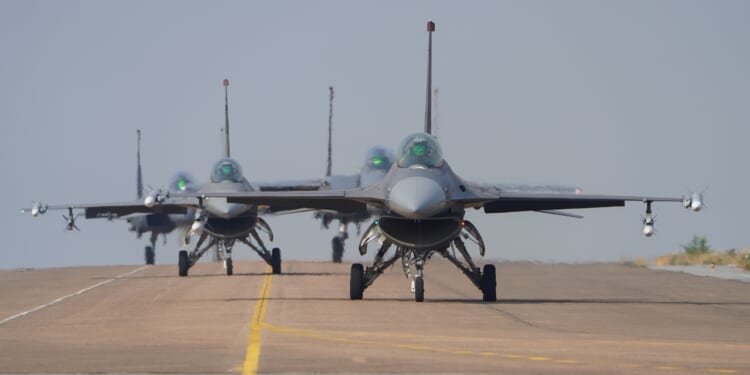The Air Force is trying to devote greater resources to “low-risk” conflicts—in other words, opponents without meaningful air defenses.
The US Air Force wants thousands of fighter jets to fight conflicts against “low-risk” adversaries.
According to an Air Force report, the service wants 1,558 fighter jets to fight future conflicts—but specifically for use in areas without significant air defenses, making fifth-generation aircraft with advanced stealth features redundant. On a practical level, the Air Force would need around 300 new fighters to meet the report’s recommendations.
The Air Force Says It Doesn’t Have Enough Fighter Jets
In August, Air Force Secretary Troy Meink signed a report that outlined the service’s assessment of the number of fighter jets the Air Force needs to effectively fight low-risk conflicts.
Titled “Long-Term USAF Fighter Force Structure,” the report was commissioned as part of the 2025 National Defense Authorization Act, as each service is making its case for more funds in its budget.
“There is insufficient top line, currently, to cover everything that we want to do,” an Air Force official told Defense News, verifying the existence and contents of the report.
“More Air Force is possible. It’s just a matter of whether it prioritizes highly enough, among all the other various things that are required within the department,” the official added.
The US Air Force currently operates approximately 1,271 combat-coded fighters. This number includes about 103 A-10 Thunderbolt II close air support aircraft that are on the chopping block, with most expected to retire in the next year or so. Thus, in order to meet the report’s recommendation, the Air Force needs at least 287 new fighter jets—and potentially more as the service retires older platforms such as the A-10s. For conflicts with medium risk, the Air Force wants 1,367 combat-coded fighters—or 191 new combat aircraft.
Understanding Low-, Mid-, and High-Risk Conflicts
The Air Force defines “low-risk” conflicts as military contingencies against adversaries who have limited air power capabilities. This environment characterized America’s 20-year conflicts in Afghanistan and Iraq, against a string of ground-based adversaries—Al-Qaeda, the Taliban, and various rebel groups—with no airpower or anti-air defenses. In that environment, the Air Force was able to operate with impunity and conduct close air support and precision strikes at will. Only Saddam Hussein’s Iraqi military presented some level of contention at the initial stages of the Iraq invasion. But that resistance was quickly quenched, allowing the US military to operate freely throughout the area of operations.
Conflicts with “medium risk” concern military operations where an adversary possesses some capabilities that could challenge US air superiority, but American capabilities are presumably stronger. Iran has long been framed as a medium risk environment, although successive Israeli and American strikes over the past summer are thought to have substantially degraded Iran’s air defense network.
Finally, potential conflicts with near-peer adversaries, such as China and Russia, are “high risk.” Although their air power capabilities differ, both China and Russia have strong air forces with advanced fighter jets, attack aircraft, electronic warfare jets, and strategic bombers. The Air Force expects to face significant resistance in a fight with China or Russia, and establishing air superiority would be a challenge, especially in a conflict with China in the Indo-Pacific. In such a conflict, slow and non-stealthy aircraft like the A-10 would essentially be sitting ducks for enemy airpower or air defenses. Conversely, the threat posed by near-peer adversaries has pressured the Air Force to invest substantially in new platforms such as the F-47 NGAD and the B-21 Raider—each of which comes with advanced capabilities that would be redundant against a low-risk adversary.
About the Author: Stavros Atlamazoglou
Stavros Atlamazoglou is a seasoned defense journalist specializing in special operations and a Hellenic Army veteran (national service with the 575th Marine Battalion and Army HQ). He holds a BA from the Johns Hopkins University and an MA from the Johns Hopkins’ School of Advanced International Studies (SAIS). His work has been featured in Business Insider, Sandboxx, and SOFREP.
Image: Shutterstock / Bluebearwing.

















